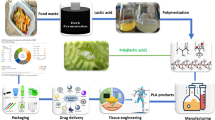Abstract
The influence of talc incorporation by melt compounding on a commercial grade of poly (lactic acid) (PLA), and the choice of the optimal compounding conditions were investigated. Two types of talc, having micrometric and submicrometric distribution, were adopted. Since the compounding itself has a dramatic influence on the properties of PLA, a study was carried out aimed at assessing the effect of processing on this resin and choosing the most suitable processing conditions. It was found that the incorporation of talc increases the viscosity during the compounding and helps the stability of the viscosity during the mixing. Furthermore, the talc, acting as a nucleating agent, enhances crystallization kinetics, so that crystallization half time can be reduced by one order of magnitude with respect to the pure PLA processed in the same way.












Similar content being viewed by others
References
Kolstad JJ (1996) Crystallization kinetics of poly (L‐lactide‐co‐meso‐lactide). J Appl Polym Sci 62(7):1079–91
Soroudi A, Jakubowicz I (2013) Recycling of bioplastics, their blends and biocomposites: a review. Eur Polym J 49(10):2839–58
Bergsma J, Rozema F, Bos R, Boering G, De Bruijn W, Pennings A (1995) In vivo degradation and biocompatibility study of in vitro pre-degraded as-polymerized polylactide particles. Biomaterials 16(4):267–74
Suuronen R, Pohjonen T, Hietanen J, Lindqvist C (1998) A 5-year in vitro and in vivo study of the biodegradation of polylactide plates. J Oral Maxillofac Surg 56(5):604–14
Ignjatovic N, Uskokovic D (2004) Synthesis and application of hydroxyapatite/polylactide composite biomaterial. Appl Surf Sci 238(1):314–9
Gupta A, Kumar V (2007) New emerging trends in synthetic biodegradable polymers–polylactide: a critique. Eur Polym J 43(10):4053–74
Singh S, Ray SS (2007) Polylactide based nanostructured biomaterials and their applications. J Nanosci Nanotechnol 7(8):2596–615
De Santis F, Gorrasi G, Pantani R (2015) A spectroscopic approach to assess transport properties of water vapor in PLA. Polym Test 44:15–22
Concilio S, Iannelli P, Sessa L, Olivieri R, Porta A, De Santis F et al. (2015) Biodegradable antimicrobial films based on poly(lactic acid) matrices and active azo compounds. Journal of applied polymer science. 132 (33) 10.1002/App.42357
Saeidlou S, Huneault MA, Li H, Park CB (2012) Poly (lactic acid) crystallization. Prog Polym Sci 37(12):1657–77
Shakoor A, Thomas NL (2014) Talc as a nucleating agent and reinforcing filler in poly (lactic acid) composites. Polym Eng Sci 54(1):64–70
Lim L-T, Auras R, Rubino M (2008) Processing technologies for poly (lactic acid). Prog Polym Sci 33(8):820–52
Garlotta D (2001) A literature review of poly (lactic acid). J Polym Environ 9(2):63–84
De Santis F, Pantani R (2015) Physical changes of poly (Lactic acid) induced by water sorption. AIP Conference Proceedings
Raquez J-M, Habibi Y, Murariu M, Dubois P (2013) Polylactide (PLA)-based nanocomposites. Prog Polym Sci 38(10):1504–42
Gahleitner M, Grein C, Kheirandish S, Wolfschwenger J (2011) Nucleation of polypropylene homo-and copolymers. Int Polym Process 26(1):2–20
Ke T, Sun X (2003) Melting behavior and crystallization kinetics of starch and poly (lactic acid) composites. J Appl Polym Sci 89(5):1203–10
Battegazzore D, Bocchini S, Frache A (2011) Crystallization kinetics of poly (lactic acid)-talc composites. Express Polym Lett 5(10):849–58
Russo P, Acierno D, Vignali A, Lavorgna M (2014) Poly (lactic acid)‐based systems filled with talc microparticles: thermal, structural, and morphological issues. Polym Compos 35(6):1093–103. doi:10.1002/pc.22757
Liu X, Wang T, Chow LC, Yang M, Mitchell JW (2014) Effects of inorganic fillers on the thermal and mechanical properties of poly (lactic acid). Int J Polym Sci. doi:10.1155/2014/827028
Pantani R, Volpe V, Titomanlio G (2014) Foam injection molding of poly (lactic acid) with environmentally friendly physical blowing agents. J Mater Process Technol 214(12):3098–107
Bergeret A, Benezet JC. (2011) Natural fibre-reinforced biofoams. International Journal of Polymer Science
Monticelli O, Bocchini S, Gardella L, Cavallo D, Cebe P, Germelli G (2013) Impact of synthetic talc on PLLA electrospun fibers. Eur Polym J 49(9):2572–83
Polymer 2002D (2005) In: Data Sheet Available from: Natureworks LLC
Huneault MA, Li H (2007) Morphology and properties of compatibilized polylactide/thermoplastic starch blends. Polymer 48(1):270–80
Li H, Huneault MA, editors (2007) Nucleation and Crystallisation of PLA. Proceedings. Society of Plastics Engineers Annual Technical Conference (ANTEC 2007): Plastics Encounter@ ANTEC 2007
Othman N, Jazrawi B, Mehrkhodavandi P, Hatzikiriakos SG (2012) Wall slip and melt fracture of poly (lactides). Rheol Acta 51(4):357–69
Gorrasi G, Pantani R (2013) Effect of PLA grades and morphologies on hydrolytic degradation at composting temperature: assessment of structural modification and kinetic parameters. Polym Degrad Stab 98(5):1006–14
De Santis F, Pantani R, Titomanlio G (2011) Nucleation and crystallization kinetics of poly (lactic acid). Thermochim Acta 522(1):128–34
Pantani R, De Santis F, Sorrentino A, De Maio F, Titomanlio G (2010) Crystallization kinetics of virgin and processed poly (lactic acid). Polym Degrad Stab 95(7):1148–59
HTP1 and HTPultra5 (2008) In: Data Sheet Available from: IMI Fabi S.p.A
Speranza V, De Meo A, Pantani R (2014) Thermal and hydrolytic degradation kinetics of PLA in the molten state. Polym Degrad Stab 100:37–41. doi:10.1016/j.polymdegradstab.2013.12.031
Acknowledgments
Imi Fabi S.p.A. (Milan, Italy) is kindly acknowledged for the supply of the talc raw materials.
The authors wish to thank Carlos Eduardo Ferreira Gonçalves and Frederico Martins Gonçalves, from the University of Minho in Guimarães, Portugal, for carrying out part of the experiments during their Erasmus project at the University of Salerno.
Author information
Authors and Affiliations
Corresponding author
Rights and permissions
About this article
Cite this article
De Santis, F., Pantani, R. Melt compounding of poly (Lactic Acid) and talc: assessment of material behavior during processing and resulting crystallization. J Polym Res 22, 242 (2015). https://doi.org/10.1007/s10965-015-0885-1
Received:
Accepted:
Published:
DOI: https://doi.org/10.1007/s10965-015-0885-1




